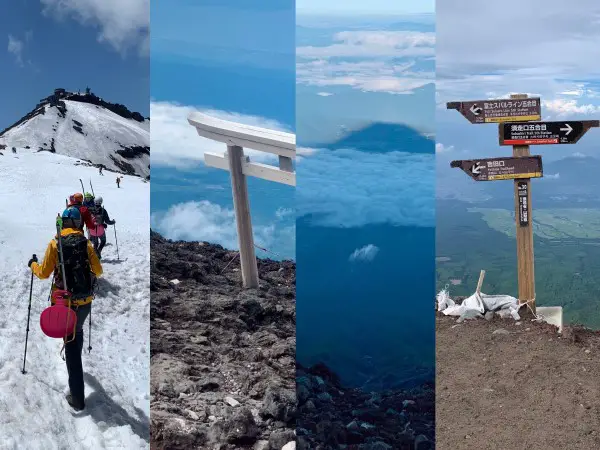
If you’re planning to climb Mount Fuji, you’ve come to the right place. This is likely the most comprehensive guide to climbing Mount Fuji available on the internet. It covers 100 questions (divided into 23 sections) with detailed answers regarding the level of difficulty, climbing season, trails, mountain huts, one-day climbs (in the summer season and off-season), safety measures, preparation, and more. It truly covers everything you need to know about climbing Mount Fuji.
I have climbed Mount Fuji three times and explored all of its trails. Therefore, in addition to the theoretical knowledge that can be found elsewhere, this guide is packed with practical, first-hand tips. Let’s get started!
What's in this blog post?
I. MOUNT FUJI DETAILS (1-6)
The perfect cone
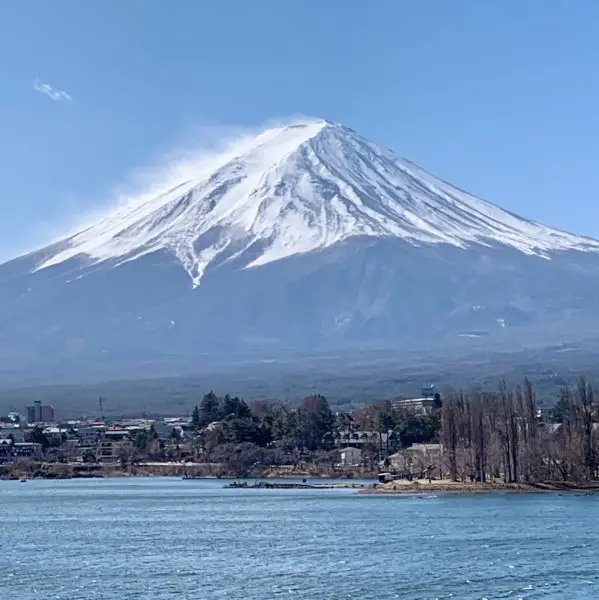
1. Why is Mount Fuji famous?
Mount Fuji is Japan’s tallest mountain and an iconic symbol, known for its perfectly shaped cone covered in snow during the colder months.
In 2013, Mount Fuji was included to the UNESCO World Heritage List as a cultural property as it “inspired artists and poets and has been the object of pilgrimage for centuries”. Mount Fuji is one of Japan’s “Three Holy Mountains” alongside Mount Tate and Mount Haku.
Mount Fuji climb is particularly famous among Japanese climbers who seek to witness the “goraiko,” which is Japan’s most celebrated sunrise observed from the summit of Mount Fuji.
2. How tall is Mount Fuji?
Mount Fuji stands 3,776 m (12,388 feet) above sea level and is the highest mountain in Japan. It is also the second-highest volcano located on an island in Asia.
Mount Fuji ranks as the 654th tallest mountain in the world. Feel free to verify, I have just counted 🙂
3. Where is Mount Fuji located in Japan?
Mount Fuji is situated on Japan’s largest island, Honshu, specifically on the border of the Yamanashi and Shizuoka prefectures, located about 100 km (60 miles) west of the Tokyo-Yokohama metropolitan area and approximately 130 km (80 miles) from the heart of Tokyo, which is Tokyo Station.
4. When does Mount Fuji have snow?
Mount Fuji looks the most beautiful in winter when its cone is covered with snow. During the summer months from June to October, it appears entirely black as the snow melts. In the transition periods of October to November and April to May, Mount Fuji is partially covered by snow.
5. How many hours do I need to get from Tokyo to Mount Fuji?
Travelling from Tokyo to Mount Fuji (Lake Kawaguchi) by local trains takes about 2 to 3 hours and involves one transfer. Alternatively, you can take the direct Limited Express Fuji Excursion, which operates from Shinjuku to Lake Kawaguchi. But you need to book it well in advance as seats sell out quickly. The journey takes approximately 115 minutes.
Travelling by direct highway buses from Tokyo or Shinjuku stations to Lake Kawaguchi takes around 2 hours, assuming there is no traffic.
6. Is Mount Fuji closer to Tokyo or Kyoto?
Mount Fuji is closer to Tokyo than Kyoto. The distance from Tokyo to Mount Fuji is nearly three times shorter than the distance to Kyoto: 100 km (60 miles) compared to 270 km (170 miles).
II. MOUNT FUJI ERUPTIONS (7-10)
brave enough for a 3km hike around Mount Fuji's crater or staying home watching Netflix? 😉
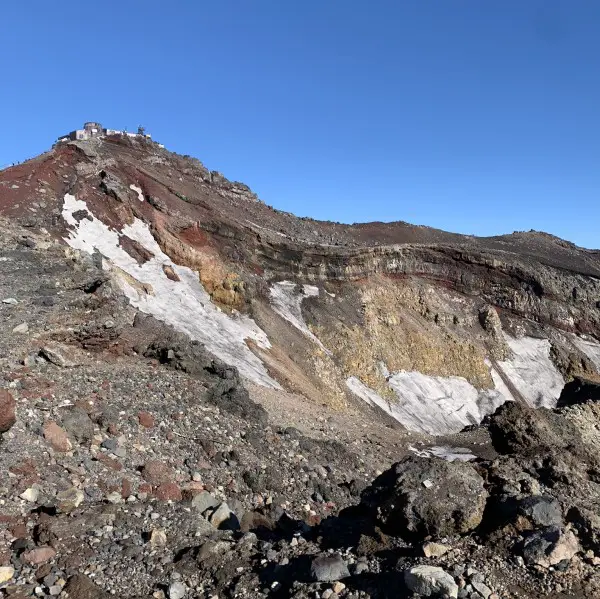
7. When was Mount Fuji’s last eruption?
Mount Fuji’s most recent eruption occurred 300 years ago, in 1707. The Hōei eruption was the last confirmed eruption of Mount Fuji.
8. Is Mount Fuji an active or dormant volcano?
Mount Fuji has been dormant since its last eruption in 1707; however, it is still classified as active by geologists. An active volcano is a volcano, which is either erupting or is likely to erupt in the future, which brings me to my next poin
9. Is Mount Fuji likely to erupt?
Mount Fuji has been dormant for 300 years, but volcanic experts agree that “the volcano will eventually erupt, although the timing and magnitude are unpredictable”.
10. What to do if Mount Fuji erupts when you are climbing?
If you are somewhere near the crater you should evacuate immediately, which basically means RUN! RUN FORREST RUN! 😉
“Volcanic Hazard Map” created by The Committee for Hazard Maps of Fuji Volcano and Yamanashi prefecture contains updated information about disaster prevention and evacuation procedures. Here is the link for your reference:
III. MOUNT FUJI CLIMB: BEST TIME TO GO? (11-12)
The Japanese have a special word for the sunrise from the top of Mount Fuji: "goraiko", which translates into "the coming of light"
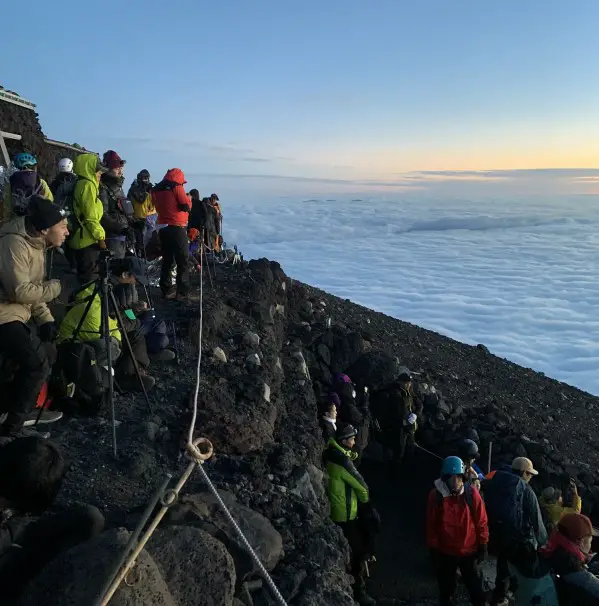
11. When can I climb Mount Fuji?
Mount Fuji’s climbing season lasts two months, from July to September. The Yoshida Trail opens slightly earlier on July 1, while the remaining trails open on July 10. The official climbing season ends on all trails on September 10. Outside the season all Mount Fuji huts and facilities are closed.
12. When should I go to avoid crowds on Mount Fuji?
To avoid Mount Fuji’s biggest crowds opt for weekdays and avoid holidays. July is generally less popular among Japanese hikers as August is school summer vacation and Obon holidays. Additionally, choose less popular trails, such as the Subashiri Trail for ascending and either the Prince Route or the Gotemba Trail for descending.
IV. MOUNT FUJI DIFFICULTY LEVEL (13-16)
The route isn't too difficult, it's just very long and the high altitude doesn't help
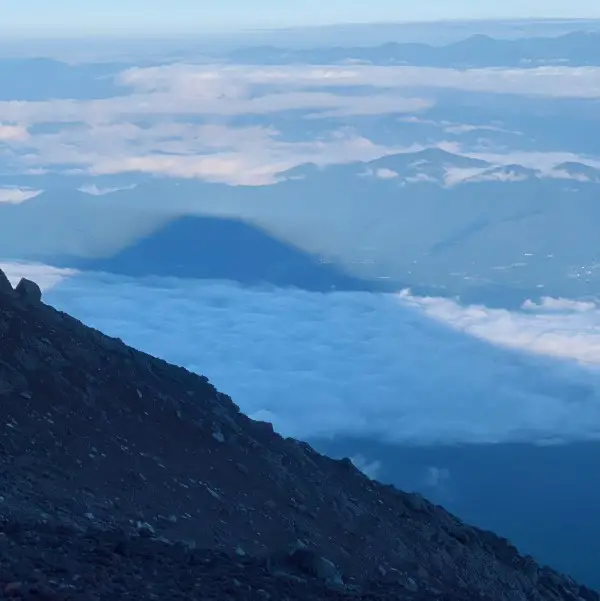
13. Is climbing Mount Fuji difficult?
Technically, Mount Fuji is not a difficult mountain to climb in the summer season. The main challenges are the considerable length of the trail, high altitude, and thus the risk of altitude sickness, as well as several steep, rocky sections and changeable weather.
14. How long does it take to climb Mount Fuji?
Mount Fuji climb duration depends on the trail you chose and your physical fitness. Generally, ascending takes from 5 to 10 hours, while the descent requires 2 to 5 hours. This results in a total climbing time ranging from 7 to 15 hours.
15. Do I need a guide to climb Mount Fuji?
Guides are not required for the Mount Fuji climb. During the official hiking season most people decide to climb Mount Fuji without a guide. The trails are well-marked and there are plenty of hikers, so it is quite impossible to get lost. Said that, you should properly prepare for the climb if you decide to go without a guide.
High altitude and changing weather are the main risks that you need to be aware and prepare for. Book the mountain hut in advance, get the hiking gear, train for the climb and.. continue reading my blog to get plenty of useful tips 🙂
16. Can I climb Mount Fuji with no mountain experience?
Yes, as you do not need any special skills and mountaineering equipment. Climbing to the top of Mt Fuji is relatively easy, as long as you’re in good physical condition, have the right gear (hiking shoes, backpack, waterproof jacket etc.) and the weather is good.
V. MOUNT FUJI CLIMBING TRAILS (17-25)
Easy access, the shortest route or fewer crowds? What's your priority? I'm sorry but you can't have it all
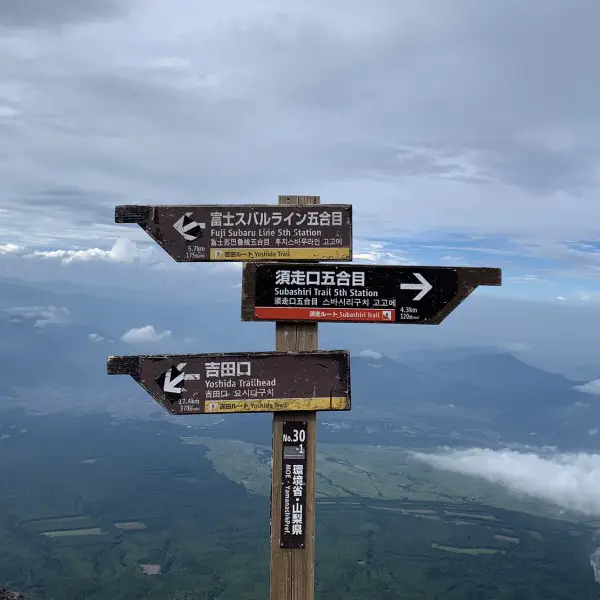
17. How many trails lead to the summit of Mount Fuji?
There are four official trails leading to the summit of Mount Fuji: Yoshida (yellow), Fujinomiya (blue), Subashiri (red) and Gotemba (green). The traditional route is divided into 10 stations, and the most popular climbing variant assumes starting the climb at one of the 5th stations.
18. How many people climb Mount Fuji every year?
In 2023, the total number of climbers was over 221,000 similar to 2019 before the pandemic (~235,000). Given the short official climbing window of slightly over two months, there are more than 3,000 climbers ascending Mount Fuji each day. The peak congestion typically occurs between 3 AM and 6 AM above the 8th Station on the Yoshida/Subashiri and Fujinomiya trails.
If you want to enjoy the tranquillity of nature, climbing Mount Fuji during the season might not be the best choice, as the presence of crowds of Japanese hikers is an integral part of this unique experience.
19. Which Mount Fuji trail is the easiest to reach from Tokyo?
The Yoshida Trail is the most accessible from Tokyo for several reasons. Firstly, there’s a direct 2.5-hour bus from Shinjuku to Fuji Subaru 5th Station. Secondly, a well-connected network of trains and frequent buses leads to Fujisan or Kawaguchi stations. Lastly, hourly buses operate from Fujisan/Kawaguchi stations to the Yoshida 5th Station during the climbing season.
20. Which trail is the most popular?
The Yoshida Trail is significantly the most popular and consequently the most crowded among all Mount Fuji trails. In 2023, more than 60% used this trail to ascend Mount Fuji. This is why starting in 2024 new regulations will be enforced at Yoshida Trail to limit the crowds:
- daily limit of 4,000 hikers;
- an additional charge of JPY 2,000 (on top of the regular JPY 1,000 fee charged on all trails).
21. Which Mount Fuji trail is the best for a beginner?
The Yoshida Trail is the best for beginners seeking to climb Mount Fuji. If you have limited mountain experience, choose this trail, as it has the biggest number of mountain huts, toilets and first-aid centres. Assistance and advice should be readily available in case of any issues. In terms of topography, it is also a relatively easy trail.
22. Which Mount Fuji trail is the shortest?
The Fujinomiya trail is the shortest and the steepest trail leading to the top of Mount Fuji. The Fujinomiya 5th Station is located slightly higher than other 5th stations, at 2,400m. This trail is often recommended for one-day Mount Fuji climbs.
23. Which Mount Fuji trail is the least crowded?
The Gotemba trail, being the longest and most demanding route to ascend Mount Fuji, is the least crowded.
24. Which Mount Fuji trail is the most difficult and why?
The Gotemba trail is the most challenging trail to climb Mount Fuji. It is much longer than other trails as its starting point – the Gotemba 5th Station – is located much lower at 1,450m
25. Which Mount Fuji trail is the best?
All four Mount Fuji trails offer a rewarding climbing experience. There isn’t a single “best” trail. It all depends on your preferences, experience, and available time. Climbing Mount Fuji is a remarkable journey no matter what route you will take. Read this guide and my climbing reports to learn more about trails and choose the one that fits you the best.
VI. YOSHIDA (YELLOW) TRAIL (26-30)
The Yoshida Trail, starting from this beautiful shrine, is the traditional pilgrimage route
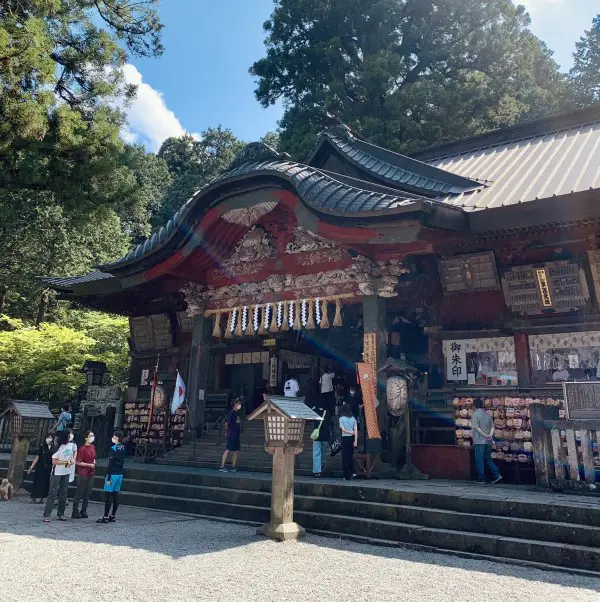
26. How difficult is the Yoshida Trail?
The Yoshida Trail presents a zigzag path on relatively flat terrain up to the 7th Station. Beyond the 7th station, the trail becomes somewhat rocky. Thanks to its extensive infrastructure, this trail is particularly well-suited for beginners, creating a sense of safety, especially for those with no mountain experience.
27. Where does the Yoshida Trail start?
Most of today’s hikers (likely 99%) start at Fuji Subaru 5th Station located at 2,300m. In such a scenario, the trail should be considered as the second shortest Mount Fuji trail. However, the traditional pilgrim’s route originates much lower at the Kitaguchi Hongu Fuji Sengen-jinja Shrine, situated at 850 m, where you can also start your climb, if you have more time. Here is a full story of my 3-day hike.
28. How do you get to the Yoshida Trail from Tokyo with public transportation?
Several options are available. You can take a direct 2.5-hour bus from Shinjuku to the 5th Station. Alternatively, take a train or bus from Tokyo/Shinjuku to Fujisan or Kawaguchiko Station (2-3 hours). From there, board a direct 1-hour bus to Fuji Subaru 5th Station. During the climbing season, buses to the 5th Station operate hourly from 6 AM to 5 PM.
29. What are the pros of the Yoshida Trail?
The Yoshida Trail has the best facilities, including the highest number of mountain huts, toilets and services. It features distinct ascent and descent paths. Easiest access from Tokyo is another advantage. You can see the sunrise not only from the top of Mount Fuji but from the entire trail. Additionally, it has a historical significance as being a traditional pilgrims’ route. If you have more time, start lower at the ancient shrine and learn about Mount Fuji’s climbing history.
30. What are the cons of the Yoshida Trail?
The Yoshida Trail is the most commercialised and the most crowded with 64% of hikers selecting this route in 2019. Those experienced hikers looking for a peaceful hike surrounded only by nature, might be disappointed.
VII. FUJINOMIYA (BLUE) TRAIL (31-35)
If you choose the Fujinomiya trail, there will be some steeper parts

31. How difficult is the Fujinomiya Trail?
The Fujinomiya Trail is generally rocky and steep. It is the shortest and steepest Mount Fuji route. Due to the challenging topography and inclination, it’s usually not recommended to beginners.
32. Where does the Fujinomiya Trail start?
The Fujinomiya Trail starts at Fujinomiya 5th Station located at 2,400m.
33. How do you get to the Fujinomiya Trail from Tokyo with public transportation?
To reach the Fujinomiya Trail by public transportation, take a one-hour shinkansen train ride from Tokyo to Shin-Fuji Station. From there, take a direct 2-hour bus to Fujinomiya 5th Station. Although the total travelling time is short, getting to the starting point of the Fujinomiya Trail is considered harder compared to the Yoshida Trail. This is because there is no direct bus connection from Shinjuku, and buses departing to the 5th Station from Shin-Fuji Station are less frequent (every 2 hours).
34. What are the pros of the Fujinomiya Trail?
The Fujinomiya Trail is the shortest trail, making it a great choice for experienced hikers with limited time. Additionally, while climbing this trail, you can take a brief detour to see the second, less known, but also spectacular crater of Mount Fuji, Mount Hoei. There are mountain huts at every station, so it’s easy to plan the hike. Lastly, it is often considered the best trail for one-day Mount Fuji climbs.
35. What are the cons of the Fujinomiya Trail?
The Fujinomiya Trail ranks as the second most crowded route, with 23% of hikers opting for this trail in 2019. The route for ascent and descent is the same, so it can get quite busy. If you are an experienced hiker, looking for a peaceful hike surrounded only by nature, it might not be necessarily suited for you. The trail is not ideal for beginner hikers due to its rocky and steep nature. The sunrise can be seen from the New 7th Station (2,780m) and beyond.
VIII. SUBASHIRI (RED) TRAIL (36-40)
Look who I met when climbing the less-traveled Subashiri Trail <3
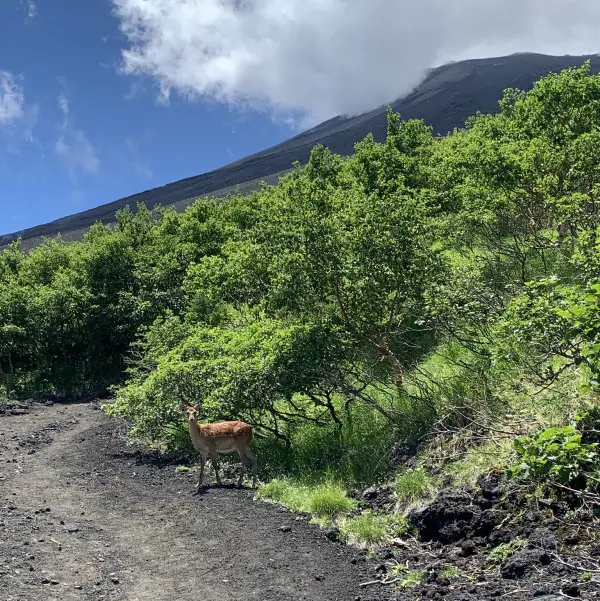
36. How difficult is the Subashiri Trail?
The Subashiri Trail is not too difficult and not too easy. It should probably be classified as a medium-hard trail. It is a bit longer than the Yoshida trail, thus more challenging. However, the trail features relatively gentle slopes and the tree cover extends nearly up to the 7th Station, making it a very pleasant choice on a sunny day.
37. Where does the Subashiri Trail start?
The Subashiri Trail starts at Subashiri 5th Station located at 2,000m.
38. How do you get to the Subashiri Trail from Tokyo using public transportation?
First you need to get to Gotemba train station and you have a few options to do this. Travelling by train with a transfer at Kozu takes around 2 hours 30 minutes. From Gotemba Station, take a direct 1-hour bus to Subashiri 5th Station. Buses are less frequent here than those departing to the 5th Station of Yoshida Trail, but at the same time they are more frequent than those for the Fujinomiya Trail’s starting point.
39. What are the pros of the Subashiri Trail?
The Subashiri Trail, up to the 8th Station, is not crowded. The tree cover in its lower sections provides nice protection from the sun. There are many mountain huts and toilets, making it relatively easy. The ascent route is different from the descent route. After leaving the forest, you can see the sunrise from anywhere.
More details about my experience hiking the Subashiri Trail: CLIMBING MOUNT FUJI OFF THE BEATEN PATH – THE SUBASHIRI TRAIL & PRINCE ROUTE
40. What are the cons of the Subashiri Trail?
The Subashiri Trail is probably my favourite route for a 2-day Mount Fuji climb, so it’s hard to point out any drawbacks. Said that, be prepared for the crowds above the 8th Station, where it merges with the Yoshida Trail. Also, I wouldn’t really recommend the Subashiri Trail for beginner hikers, as it is a longer route.
IX. GOTEMBA (GREEN) TRAIL (41-45)
Are you ready for the run?
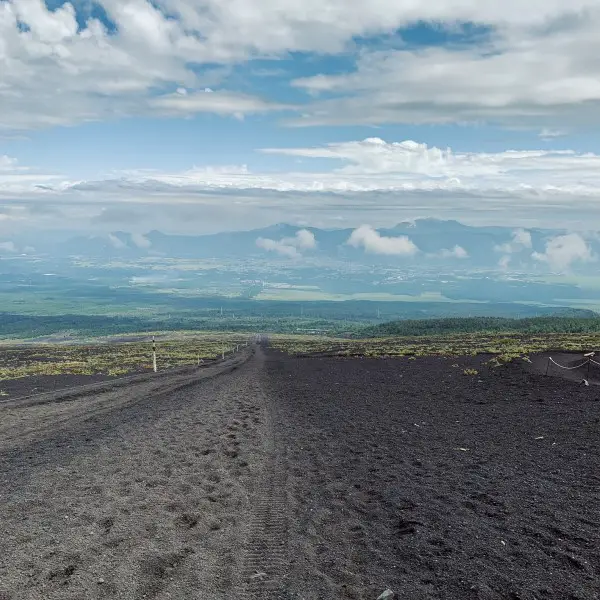
41. How difficult is the Gotemba Trail?
The Gotemba Trail is the most challenging among the official Mount Fuji trails. It features the highest elevation gain and is also the longest. You should only consider this trail if you are an experienced hiker with plenty of time. There are only 4 mountain huts along the route, so careful planning is essential. On the other hand, the Gotemba Trail can be an excellent choice for descending, as you can easily run down on the volcanic gravel, which makes your descent fun and relatively quick.
42. Where does the Gotemba Trail start?
The Gotemba Trail starts at the Gotemba 5th Station, what a surprise 🙂 , which is situated much lower than other 5th stations – at 1,450m.
43. How do you get to the Gotemba Trail from Tokyo with public transportation?
Similarly to the Subashiri Trail, you need to first travel to Gotemba Station. Travelling by train with a transfer at Kozu takes around 2 hours 30 minutes. From Gotemba Station, take a direct 30-minute bus to the Gotemba 5th Station. Watch out when planning as there are only five buses departing daily to the 5th Gotemba Station during the climbing season daily .
44. What are the pros of the Gotemba Trail?
The Gotemba Trail is a significantly less crowded trail compared to the other official Mount Fuji routes. In 2019, only 5% of climbers chose this trail. If you want to avoid people, this is your best option. Of course, be prepared to meet some of them at the summit. Although it’s dusty, the surface of volcanic gravel makes it fantastic for descending. Until the 7th Station there are separate trails for ascent and descent. Ensure to take the correct trail when ascending, as climbing the descent trail (“The Great Sand Run” or Osunabashiri) made of volcanic gravel would be extremely hard.
More details about my experience on the Gotemba Trail: CLIMBING MOUNT FUJI FROM THE BOTTOM – THE YOSHIDA TRAIL AND GOING DOWN – THE GOTEMBA TRAIL
45. What are the cons of the Gotemba Trail?
The Gotemba Trail is the longest. Due to the limited number of mountain huts, you should carry sufficient water and snacks. There are no huts and toilets until you reach the first hut at the 6th Station at 2,590m. Frequent dense fog can add a unique experience when descending, but it might be a bit annoying on your way up.
X. PRINCE ROUTE (46-49)
The Prince Trail offers, without a doubt, the best views of the peak of Mount Fuji
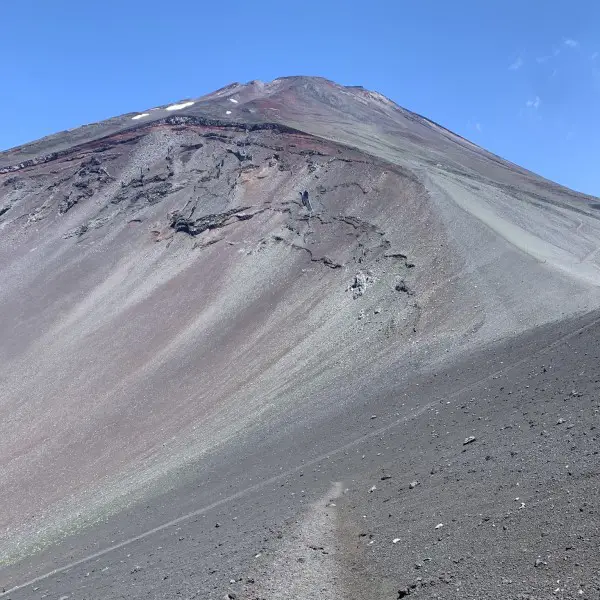
46. What is the Prince Route?
The Prince Route is the fifth slightly less official Mount Fuji route. It connects two standard trails Fujinomiya and Gotemba, passing through the spectacular crater of Mount Hōei located on Mount Fuji southeastern side.
The trail earned its name from Japan’s Emperor, who climbed this route in 2008 when he was still the Crown Prince of Japan.
47. Where does the Prince Route start?
The Prince Route starts at Fujinomiya 5th Station, then diverges from the blue route at the 6th Station. It traverses the Hoei crater before eventually merging with the Gotemba Trail at its 6th station.
48. What are the pros of the Prince Route?
The Prince Route is less known, hence less crowded. It offers you an opportunity to explore the captivating crater of Mount Hōei (2,693m), formed from Mount Fuji eruption in 1707. From its top you can enjoy the breathtaking majesty of Mount Fuji. Additionally, you can experience a small section of “The Great Sand Run” on the Gotemba Trail and run down the slopes of Mount Fuji. In my opinion, it’s the most diverse and probably the best route for descending.
More details about my experience hiking (down) the Prince Route:: CLIMBING MOUNT FUJI OFF THE BEATEN PATH – THE SUBASHIRI TRAIL & PRINCE ROUTE
49. What are the cons of the Prince Route?
I wouldn’t recommend the Prince Route for the ascent as the volcanic gravel around Mount Hoei can be a little bit challenging for climbing.
XI. MOUNT FUJI DESCEND (50-52)
Getting to the top is the easy part...
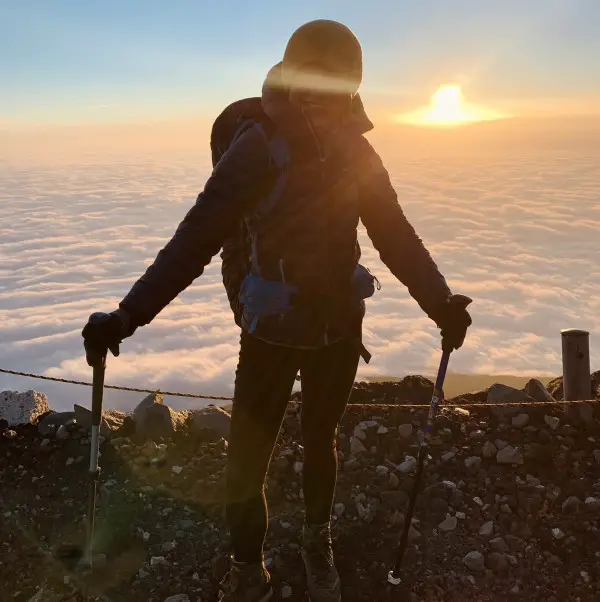
50. Is descending Mount Fuji difficult?
Even though going down Mount Fuji can be twice as fast as climbing, it is often considered to be twice as hard. After reaching the summit, adrenaline levels are lower, and you are also much more tired. The trail leading down is made up of loose rocks and pebbles and slipping is easy. Going down is much harder for your knees.
Honestly, climbing Mount Fuji has never been too hard for me, but I’d be lying if I said I wasn’t dead tired going down.
51. Do I need to go down the same trail?
No, you do not have to. Once you reach the summit of Mount Fuji, you have the freedom to choose any trail down. Walking along the crater rim allows you to access the trail of your choice. If you ask me, taking the same trail down is a bit of wasting a great opportunity. A different route down gives you a fresh hiking experience and new views. You will get to know Mount Fuji from a different side 🙂
52. Which trail is the best to go down Mount Fuji?
Any trail you did not take on your way up 🙂 I particularly enjoyed the Prince Route, which allows you to explore Mount Hoei, which is Mount Fuji’s second crater as well as the Gotemba Trail, where you can easily run down a short section of the volcanic gravel, which is quick and so much fun!
XII. GETTING TO THE 5TH STATION (53-55)
Try to arrive at the bus stop early and stand in line to get a seat on the bus, at least on the way back when you're dead tired
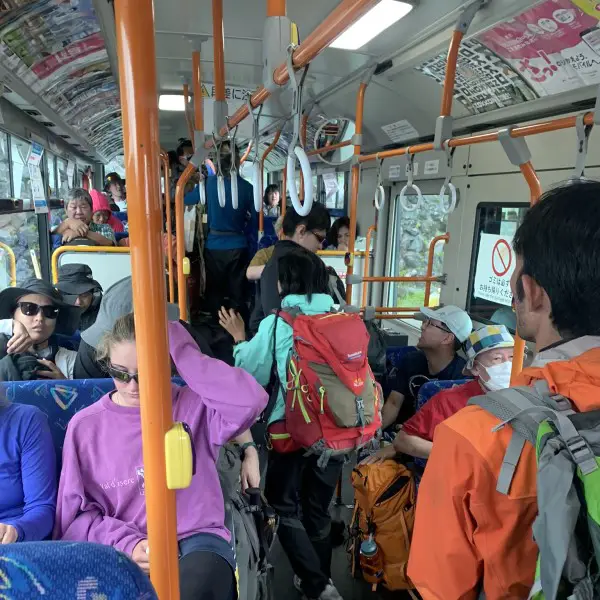
53. How do I get to the 5th Station?
In the climbing season, direct buses operate daily between nearby train stations and all the 5th stations. However, in 2023, off-season bus services were limited to the Fuji Subaru 5th Station.
I was surprised by the buses I took for Fujinomiya and Subashiri trails. They were not long-distance buses with comfortable seats, but rather regular city buses. Some passengers had to stand for more than an hour due to the limited seating. To secure a seat, try to get to the bus stop early. Trust me, especially after your climb, you don’t want to stand in the bus.
For bus schedules and more information, you can refer to the following links:
MOUNT FUJI BUS SCHEDULE: CLIMBING SEASON
MOUNT FUJI BUS SCHEDULE: OFF-SEASON
54. Where can I buy a bus ticket?
You can buy bus tickets at the bus stop or pay with your PASMO/SUICA card for payment on the bus. Seat reservations are not possible.
55. Can I get to the 5th Station by car?
During the climbing season, private or rental cars are not permitted to access the 5th Station directly. Instead, you’ll need to park your car in a designated transfer parking area and take a shuttle bus to reach the 5th Station.
XIII. CLIMBING MOUNT FUJI WHILE TRAVELLING IN JAPAN (56-59)
Need some souvenirs? You can get them on the top of Mount Fuji 🙂

56. I’m travelling in Japan, what should I do with my luggage while I’m climbing Mount Fuji?
First of all, Japan is an incredibly safe country, so you should not worry about it. You have a few options for handling your luggage while climbing Mount Fuji:
Hotel Storage: If you’re returning to the same hotel after your climb, most accommodations will store your luggage.
Coin Lockers: If you’re moving to a new location after your climb, you can use coin lockers available at all train stations in Japan. These lockers are secure and come in different sizes to accommodate various bag sizes.
5th Station Lockers: Available at the Yoshida and Fujinomiya 5th Stations.
57. I’m travelling in Japan, and I don’t have much time (and/or experience). What’s the most optimal Mount Fuji climbing route for me?
If you’re short on time and experience but still want to climb Mount Fuji on your way from Tokyo to Kyoto or Osaka, I recommend the following approach:
Book a Mountain Hut: Even if you have limited time, book a mountain hut, do not opt for a day hike. It will allow you to rest before your final ascent and.. it’s both an interesting and fun cultural experience. Japanese mountain huts are different from any mountain lodges you’ve likely visited.
Yoshida Trail Ascent: Climb Mount Fuji via the easiest and the most accessible Yoshida Trail, the most popular route, suitable for beginners.
Fujinomiya Trail Descent: Descend via the Fujinomiya Trail. This route is shorter and steeper, making it a quicker descent if you’re short on time. If you travel west after the climb (Kyoto, Osaka, Hiroshima etc.), this route has the best shinkansen accessibility.
Taking these two routes will help you to minimise travel time. They are also suitable for beginners, as they feature many facilities. Bear in mind, the Fujinomiya Trail is steep and rocky, so you need to be extra careful when descending.
However, if you have a little bit more time (and experience), climb the Subashiri Trail and take the Prince Route on the way down to avoid the crowds and get a more comprehensive hiking experience.
In both scenarios use shipping services to deliver your luggage, which brings me to the next point.
58. I’m travelling in Japan and I want to take a different trail to descend from Mount Fuji. What should I do with my big luggage?
Before Mount Fuji climb, use Japan’s efficient shipping services, often referred to as “takkyubin,” to send your bigger luggage to your next destination. Companies like Yamato Transport (with the black-yellow cat logo) offer reliable and fast shipping services. Unless you travel to more remote parts of Japan like Hokkaido or Okinawa, they can deliver your bags overnight to your next destination.
XIV. MOUNT FUJI HUTS: RESERVATIONS (60-65)
You can't just walk into a hut on Mount Fuji
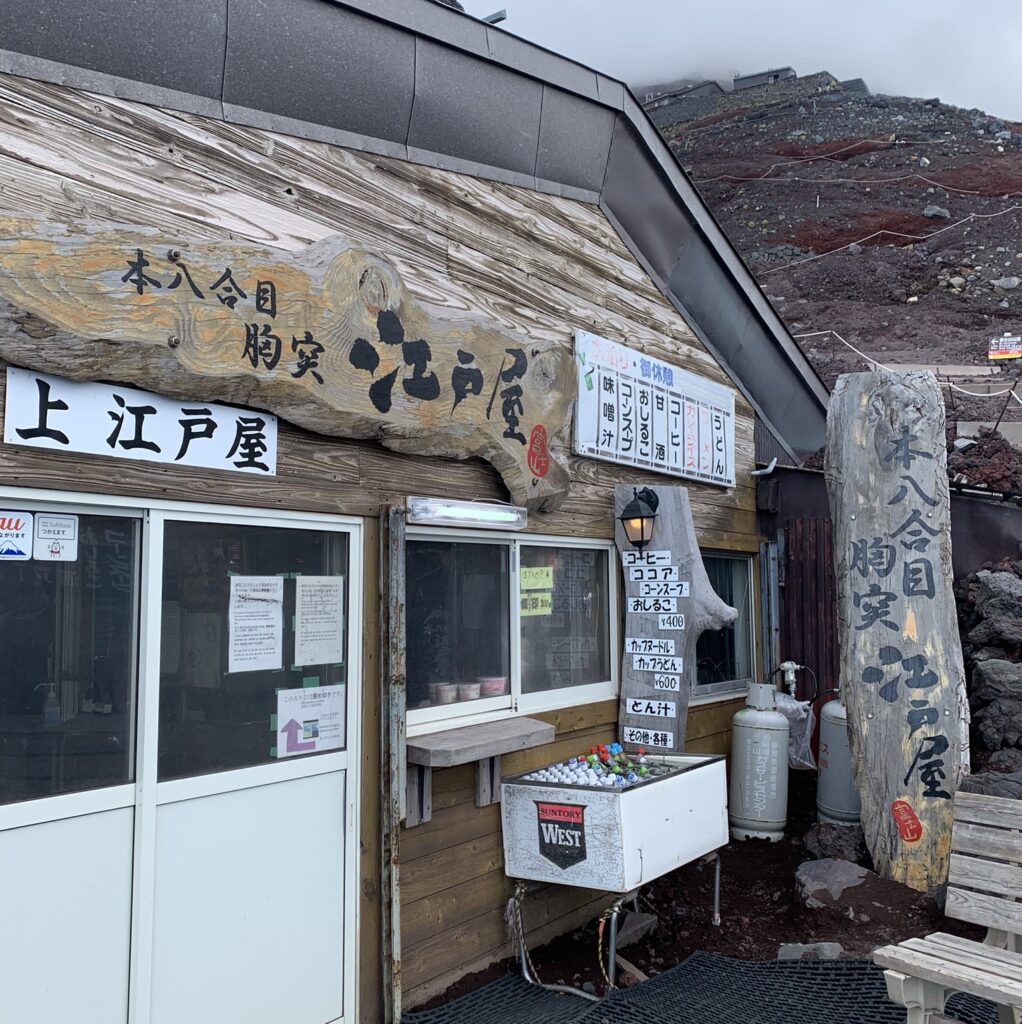
59. Are reservations required for Mount Fuji huts?
Yes, all huts on Mount Fuji require reservations. You won’t be able to walk in without a prior booking. Mount Fuji huts get very busy in the climbing season.
60. How can I book a Mount Fuji hut?
Booking procedures for Mount Fuji huts can vary. Some huts allow online bookings, while others may only accept reservations by phone, often only in Japanese. Detailed information on how to make a reservation are usually indicated on the official websites.
Check out this complete guide how to book Mount Fuji hut for more details:
BOOKING MOUNT FUJI MOUNTAIN HUT – LIST OF HUTS ON ALL TRAILS
61. When should I book a Mount Fuji hut?
Bookings for Mount Fuji huts typically start from April or May. The specific start dates are usually stated on hut’s website. Only a few places accept advance bookings. Try to book Mount Fuji hut as soon as possible, as spaces fill up quickly, especially on the 8th stations and weekends.
62. Can I book Mount Fuji hut without speaking Japanese?
Some huts yes, some no. Several mountain lodges have English websites, and if not, often with the help of Google Translate in Chrome, you should be fine. When it comes to calling the huts for reservations, you may or may not be able to communicate in English. But it’s always worth trying! Especially since you have my blog with all the tips.
Check out this complete guide how to book Mount Fuji hut for more details:
BOOKING MOUNT FUJI MOUNTAIN HUT – LIST OF HUTS ON ALL TRAILS
Hiking & mountain huts in Japan – Interesting fun facts:
THINGS TO KNOW BEFORE BOOKING A MOUNTAIN HUT IN JAPAN BY PHONE
63. How do I proceed with payment after making a reservation at Mount Fuji hut?
For most cases, payment for Mount Fuji huts is done upon arrival. Whether you’ve booked online or through a phone call, you’ll typically settle the payment directly at the hut when you arrive.
64. Can I pay by credit card at Mount Fuji huts?
Credit cards are generally not accepted at the majority of Mount Fuji huts. Payments are typically in cash only, so it’s important to have Japanese yen with you.
65. How did the pandemic affect Mount Fuji huts?
In 2023, the accommodation capacity of Mount Fuji huts was reduced to about a half or a third of their regular capacity before the COVID-19 pandemic. Ensuring a spot in Mount Fuji hut has become even more difficult, book your hut early!
XV. MOUNT FUJI ACCOMMODATION DETAILS (66-73)
A sleeping place on Mount Fuji. Sometimes there is a division between sleeping spots and sometimes there is not. Overall nice & cozy 😉

66. What is Mount Fuji accommodation like?
There are 40 mountain huts on Mount Fuji. All of them offer similar simple accommodations, food, and toilet facilities. As you climb higher, conditions tend to become more basic, as usual in mountains. Mount Fuji huts provide shared dormitories, where hikers sleep on mattresses inside provided sleeping bags.
Groups are accommodated together, so there’s no need to worry about being separated from your friends. If you are climbing with a partner, you’ll sleep close to each other.
Some huts provide dividers or curtains to offer a degree of privacy. For instance, when I climbed with my partner, we had a nice private space separated by curtains from another couple. During my solo climb, I slept near a lady I didn’t know, and there was no divider between us. Female solo hikers are never placed between men, and vice versa.
67. Can I book a private room at Mount Fuji hut?
Most Mount Fuji huts offer only shared rooms. But if you need some privacy and are lucky enough to ensure a spot, there are two mountain lodges offering private rooms.
Two Tomoe-kan huts are located at the 7th and 8th Stations of the Yoshida Trail. As stated on their website, all rooms in both huts are private. Here are all the links for your easy reference.
Online booking Tomoe-kan (7th Station) in English
Online booking for Tomoe-kan (8th Station) in English
68. Can I camp at Mount Fuji?
Camping at Mount Fuji is prohibited. It’s the most sacred mountain in Japan, which has been worshipped for centuries. You can either climb Mount Fuji without camping, or camp at one of the campsites with a view of Mount Fuji.
69. Do I need to bring my sleeping bag?
No, you don’t need to bring your own. Sleeping bags are available in Mount Fuji huts. While the provided sleeping bags in the huts are clean and comfortable, especially when compared to the blankets in mountain lodges in Nepal, you can still bring your own sleeping bag liner for enhanced comfort.
70. Can I take a shower on Mount Fuji?
No, showers are not available in Mount Fuji huts. You can bring wet wipes to freshen up a bit if needed.
71. Can I charge my phone in the Mount Fuji hut?
It depends on the hut. In some Mount Fuji mountain huts, charging smartphones and other devices is prohibited due to limited power supply. This is occasionally stated on the hut’s website. In the last hut I stayed at, although there was a sign near the power outlet indicating a fee for charging, people were able to charge their devices for free. Interestingly, in contrast to Japan’s usual strict adherence to rules, there seems to be some flexibility here. Said that, carry a power bank with you.
72. Are there garbage bins on Mount Fuji?
There are no garbage facilities on Mount Fuji, so you must carry all your trash down with you (except for PET bottles purchased in the mountain huts). Remember to bring a plastic bag for your trash.
73. What is the toilet situation on Mount Fuji?
During the regular climbing season from July to September, you can use both the toilets in the mountain huts and the public ones. The toilets utilise an eco-friendly system without discharging waste, so that brown water you’ll see, it’s normal – it’s just part of this process. Even if you are an overnight guest, you are expected to pay a small fee (usually around 200 – 300 JPY) to use a toilet. Outside the climbing season, toilets are unavailable.
XVI. MOUNT FUJI WIFI & PHONE CONNECTION (74-75)
Are you sure you need a wifi here?

74. Is there phone reception on Mount Fuji?
Yes, most of Mount Fuji now has 4G coverage. Additionally, during the summer climbing season, 5G service has been made available at Mount Fuji’s summit. However, based on my experience, there might be certain parts of the trails with no reception.
75. Is there WIFI on Mount Fuji?
Yes, free WiFi is available at 46 locations, including mountain huts on Mount Fuji. I haven’t personally connected, so I am not sure how good it is.
Here’s something to read before connecting to Mount Fuji’s WiFi — an oldie but a goodie 🙂
THE GUARDIAN: Now that any idiot can send a selfie from Mount Fuji, have we hit peak Wi-Fi?
XVII. MOUNT FUJI HUTS: FOOD & DRINKS (76-79)
A typical dinner served in a hut on Mount Fuji. Itadakimasu! This is what you say before eating in Japan, clapping your hands 🙂
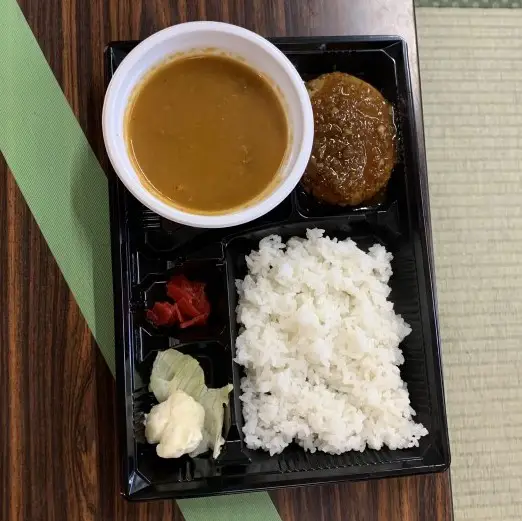
76. Do I need to bring my food when climbing Mount Fuji?
You don’t have to, as food and drinks are available in the Mount Fuji mountain huts. However, if you want to save some money or if you’re climbing the less popular Gotemba Trail, you should bring sufficient water and snacks. In fact, bringing your favourite snacks is always a good idea. That’s one of the reasons why I love hiking in the mountains – to eat my snacks 🙂
77. What kind of food is served at Mount Fuji huts?
Mount Fuji huts provide standard dinners and breakfasts for overnight guests. If you’re a vegetarian or have allergies, it’s usually not possible to make special requests. However, since I haven’t stayed in all the huts and can only speak from my experience in three of them, you should always ask.
Dinner typically consists of a meat patty or meat curry with rice, served with miso soup and water. Breakfast options vary more from hut to hut, but the ingredients are usually the same: rice and meat. I’ve seen fried tofu pouches filled with rice and some sausages as well.
On average, breakfast costs around JPY 1,000, while dinner ranges from JPY 1,000 to JPY 2,000. You’ll usually need to decide on meals when booking the hut.
78. Can I buy food at Mount Fuji huts if you don’t stay there?
The standard dinner meal served in Mount Fuji huts is usually only available for the overnight guests, but you can always buy drinks, snacks or cup noodles in any hut. In some you might even find more substantial meal options. Higher you climb, the more crowded the huts are, the more basic food, and service is, but you will never starve at Mount Fuji.
79. Should I bring a water filter bottle with me?
No, you can leave it at home. There is no water available on Mount Fuji. Unfortunately, the only option is to buy plastic bottled water, which is available for 500 JPY (0.5l). It’s a good idea to bring wet wipes or hand sanitizer to clean your hands, as there is also no water available in the toilets for washing.
XVIII. MOUNT FUJI COSTS (80-83)
Budget around 15,000 JPY to cover expenses for the Mount Fuji climb, incl. entrance fee, accommodation, food, water & toilets
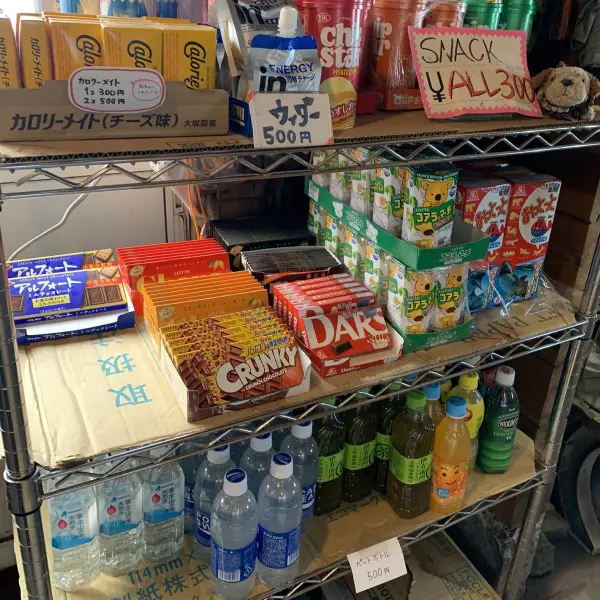
80. How much does Mount Fuji entrance fee cost?
Once reaching the 5th Station, all climbers are required to pay a mandatory JPY 1000 fee, which helps to protect and maintain the trails. Additionally, starting in 2024 climbers ascending Mount Fuji from the most popular trail – Yoshida – will be charged JPY 2,000 to ease congestion (on top of the regular fee).
81. How much does the overnight stay at Mount Fuji cost?
Prices for one person for one night, including two meals, can range from JPY 8000 to JPY 12,000. Mountain huts along the Yoshida Trail are slightly more expensive due to higher demand. Prices are often higher on Fridays, Saturdays, and holidays. Additionally, prices at higher-altitude huts are also… higher.
82. How much does the food and drinks cost on Mount Fuji?
As you climb higher, additional transport costs contribute to higher expenses. On average, breakfast prices are around JPY 1,000, while dinner costs range from JPY 1,000 to JPY 2,000.
Here are some prices from the Ue-Edoya hut located at the 8th Station, accessible from the Yoshida and Subashiri Trails, where I stayed in 2023:
- Coffee 400 JPY
- Tea (black or green) 400 JPY
- Water (0.5l) 500 JPY
- Snacks (small packs of potato chips, biscuits, chocolate) 300 JPY
- Corn soup 400 JPY
- Cup Noodles 700 JPY
- Ramen 700 JPY
- Vegetable Udon 700 JPY
- Curry Rice 1200 JPY
- Gyudon (beef rice bowl) 1000 JPY
83. How much does using a toilet cost on Mount Fuji?
The fee varies between 200 and 300 JPY, depending on the altitude and whether you are an overnight guest or not.
XIX. CLIMBING MOUNT FUJI IN ONE DAY IN THE SEASON (84-87)
The shortest trail - Fujinomiya, starting at 2400m, is the most popular choice for one-day climbs
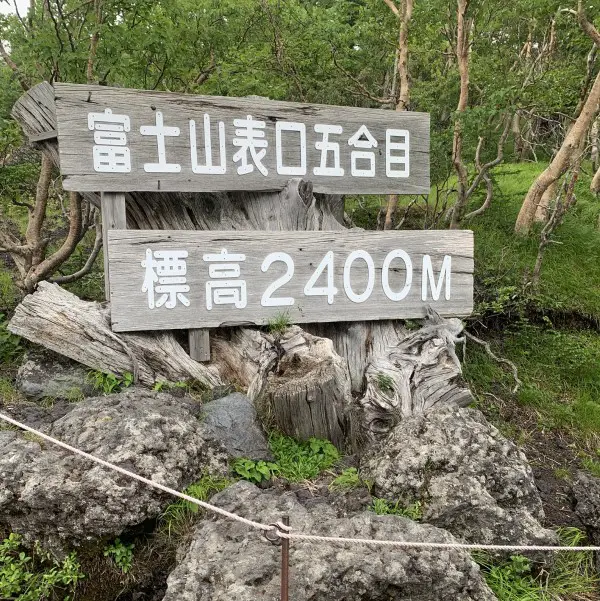
84. Can I climb Mount Fuji in one day – without staying at a mountain hut?
Although it is not recommended, you can climb Mount Fuji without an overnight stay in the hut. But you must be aware of a few things. The climb is very long, and the altitude risk is high. Unless you are fit and have mountain experience (climbed mountains above 3000 m), I don’t recommend it. Mount Fuji standing at almost 4000m is a Big Boy after all, so you must be well prepared, especially if you plan a “bullet climbing”.
85. What is Mount Fuji bullet climbing?
It is climbing from the 5th Station at night with the intention of reaching the summit by sunrise without staying in a hut. This style of climbing significantly increases the risk of injury or illness. Honestly, it doesn’t seem much fun to me. I saw many people who climbed this way and no one really seemed to enjoy neither the sunrise nor the hike as they were so exhausted.
2024 UPDATE: To prevent bullet-climbing starting in 2024 all four Mount Fuji trails will be closed from 4pm to 3am for hikers without reservations at the mountain huts. Book a mountain hut to to climb at night and see the famous sunrise from the summit!
86. What is the easiest way to climb Mount Fuji in one day?
Option 1: Take the shortest Fujinomiya Trail leading to the summit.
Stay the night before the climb near Fujinomiya Station to be able to catch the first morning bus departing at 6:35 AM, and arriving at 7:55 AM at the 5th Station. Be ready for a long hiking day of around 10 hours, without hiking the crater summit loop. The ascent should take about 5-7 hours and descend 2-4 hours.
Option 2: Alternatively, take the Yoshida Trail – the most accessible route from Tokyo.
Stay the night before the climb near Lake Kawaguchi to catch the first morning bus departing from Fujisan Station at 6:20 AM or from Kawaguchi Station at 6:30 AM, reaching the Fuji Subaru 5th Station by 7:25 AM. Be prepared for an even longer hiking day exceeding 10 hours, without hiking the crater summit loop. Expect around 6-7 hours for the ascent and 4-5 hours for the descent.
You can also take a direct 2.5-hour bus from Shinjuku to Fuji Subaru 5th Station. However, the first bus arrives at the 5th Station at 9:20 AM, which is, if you ask me, unless you’re super fit and fast, a bit late to start a one-day Mount Fuji climb.
87. Where can I rest if I don’t stay overnight at the mountain hut?
Resting outside Mount Fuji huts is possible. Sometimes you will find small benches; otherwise, you will have to sit on the rocks or ground. There are usually plenty of hikers doing this because they could not get a room or just want to save money. Although it is certainly doable, it will be extremely unpleasant, especially if it rains or is windy.
XX. CLIMBING MOUNT FUJI OFF-SEASON (88-93)
Am I sledding down Mount Fuji? It seems so 🙂
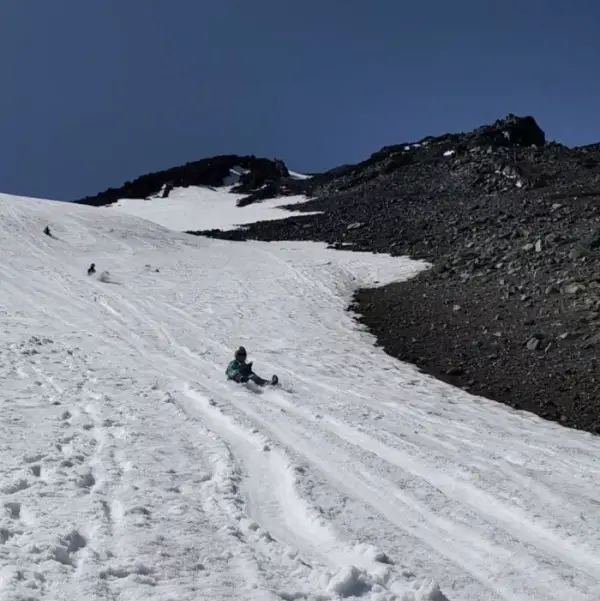
88. Is climbing Mount Fuji off-season illegal?
No, it’s not illegal. However, according to the official Mount Fuji climbing website, you must follow the following guidelines in the off-season:
- No one is allowed to ascend the mountain unless they are fully prepared.
- A Climbing Plan must be completed and submitted.
- Off-season climbers bring their own portable toilets.
Click here: THE OFFICIAL MOUNT FUJI CLIMBING OFF-SEASON GUIDELINES
The first rule applies to climbing not only Mount Fuji but any high mountain. Secondly, submitting a climbing plan with a route, schedule, gear, group members and emergency contact is a normal practice when hiking in Japan.
89. Can I climb Mount Fuji year round?
No, you cannot. To start your hike, the road leading to the 5th Station must be open, and it is sometimes closed during winter due to snow.
90. Can I climb Mount Fuji in winter?
Mount Fuji’s winter temperatures can drop to -40°C and the winds can be extremely strong. Unless you are experienced in winter mountaineering, you should not attempt to climb Mount Fuji. Outside the regular summer season, it can be possible to climb Mount Fuji in late spring or early autumn (May-July and September-October).
91. Do I need a guide to climb Mount Fuji off-season?
Unless you have extensive experience (in mountains above 3,000m), intend to hike during the shoulder months of June or September, and have an experienced hiking buddy, I don’t recommend climbing Mount Fuji without a guide.
Mount Fuji’s weather can be highly unpredictable and the hike is very long. In case of any emergencies, there might be no one around to help you. Mountain huts are closed, and there is no access to medical assistance. If there is still snow on the mountain (typically until late May and from October), proper mountaineering gear is necessary.
92. How can I climb Mount Fuji in off-season?
If you meet all above criteria, start planning a one-day Mount Fuji hike. Check the weather forecast and do not set off, if it is not good. Start your climb as early as possible to be able to go down before dark. The total climbing time ranges from 7 to 15 hours, but if you plan a day hike, it should not take you more than 10 hours.
Although most huts are closed during the off-season, as far as I know there is at least one hut open at the Yoshida Trail’s 6th Station. Book your spot before or/and after a hike. Keep in mind, it will be colder than in summer months, so pack some extra layers.
Currently (2023-2024), off-season buses are only scheduled for the Fuji Subaru 5th Station, which is the starting point of the Yoshida Trail. If you’re planning to climb the Fujinomiya Trail, arrange your own transportation.
93. Which Mount Fuji hut is open all year?
Satogoya mountain hut, located at 2,320m at the 6th Station of the Yoshida Trail, remains open throughout the year. At least that’s what stated on its official website. I don’t have a personal experience.
It takes approximately 30 minutes to reach the hut from the bus stop at the 5th Station. You can book the hut online via email. An overnight stay at the hut will help in acclimatization, and allow you to start your climb early in the morning. Here are the mountain hut details for your reference:
XXI. MOUNT FUJI WEATHER (94-96)
The golden rule: be prepared for all kinds of weather
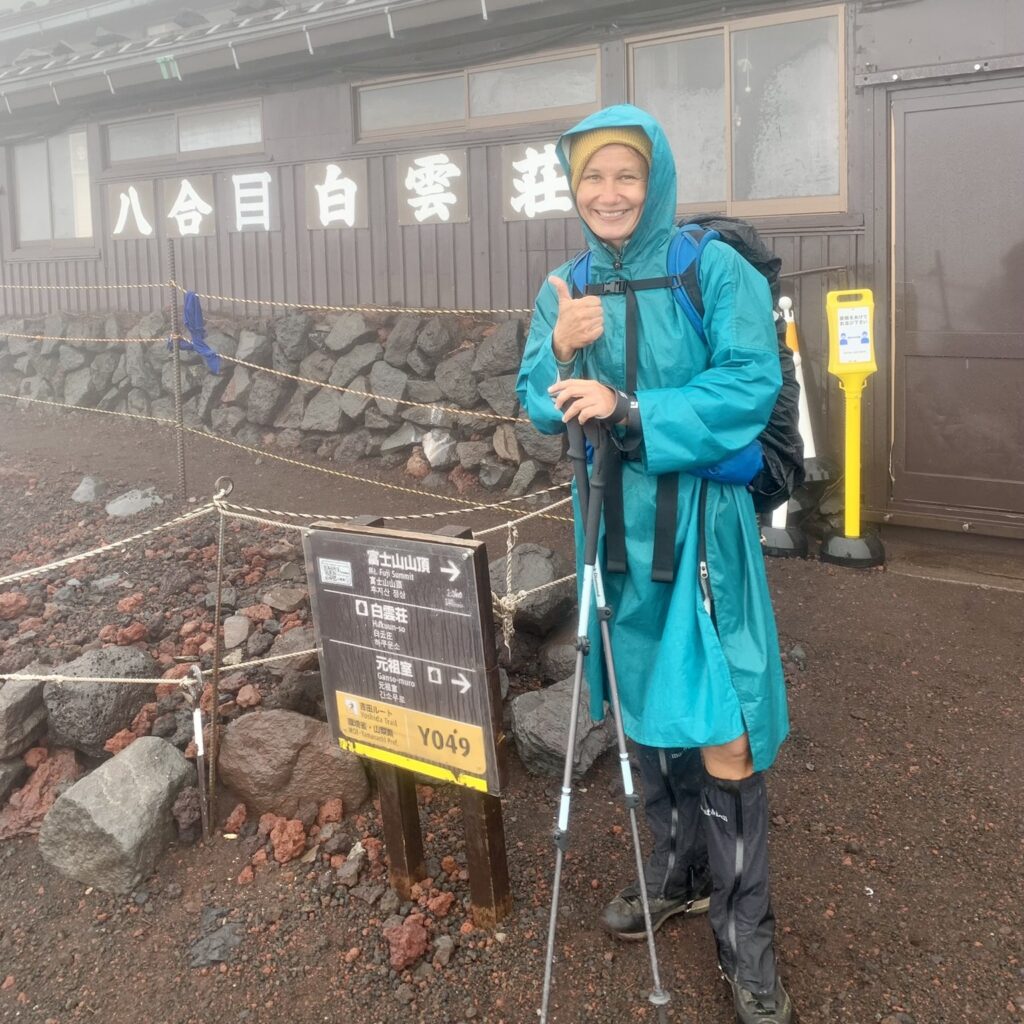
94. How is Mount Fuji weather?
In one word: changeable. In two words: very changeable. I experienced hot sun and wore only a tank top, as well as rain, fog, and very strong winds all during one climb. If you plan a sunrise hike, it will be very cold. Don’t be fooled by Tokyo’s hot and humid summer weather. If you can, pack gloves and a beanie.
The temperature difference between the foot of the mountain and the summit can exceed 20°C (at night even more – 30°C). When the winds are blowing, you will feel even colder. Make sure to prepare protection against the sun, wind, rain, and cold
95. How to check the Mount Fuji forecast?
This is the most reliable source of Mount Fuji weather information I know, use and can recommend:
96. Should I hold off making hut reservations as long as possible to monitor the weather forecast?
I know, this can be a bit tricky. Japan’s rainy season in the Kanto region, where Mount Fuji is located, typically starts at the beginning of June and ends around July 20. However, this doesn’t mean that there are no rainy days in August. Additionally, recent climate change has affected Japan’s weather patterns, making them more unpredictable. That being said, it’s hard to predict the weather on Mount Fuji.
Since spots in Mount Fuji huts fill up quickly, I wouldn’t recommend waiting for the weather forecast unless you have a lot of flexibility with your dates and climbing routes. Especially if you want to ensure a spot at the 8th Station, book it as fast as it’s possible.
XXII. MOUNT FUJI ALTITUDE SICKNESS (97-99)
There is no scientific evidence to support the claim that canned oxygen sold on Mount Fuji trails can reduce the risk of the altitude sickness, but we've all heard of the placebo effect...

97. Can I get altitude sickness on Mount Fuji?
Yes. What’s more, altitude sickness is a frequent reason why some hikers give up their Mount Fuji climbing plans, so you need to be aware and prepared for this potential risk. Due to the reduced oxygen levels at higher altitudes, certain people might start to experience first symptoms of altitude sickness (headache/ dizziness) above 3000m.
98. How to prevent altitude sickness on Mount Fuji?
Climbing slowly and good hydration are the most effective and straightforward methods to prevent altitude sickness symptoms. Start your Mount Fuji climb as early as possible. Take a lot of breaks and drink plenty of water to acclimatise. Avoid alcohol on your climb. Avoid “bullet climbing” and instead rest overnight in the mountain hut. You can buy canned oxygen, available at the 5th Station and in the Mount Fuji huts along the trail, if you believe it can help.
99. What should I do if I get altitude sickness symptoms on Mount Fuji?
Take painkillers (ibuprofen or paracetamol) to ease your headache. However, do not continue climbing, if the headache worsens. Ignoring altitude sickness and climbing higher, will only make them worse and can be very dangerous. The best way to stop the altitude sickness symptoms is to simply start going down.
XXIII. MOUNT FUJI PACKING LIST (100)
That's Basically all you need. Plus a good weather, but this you can't pack 😉
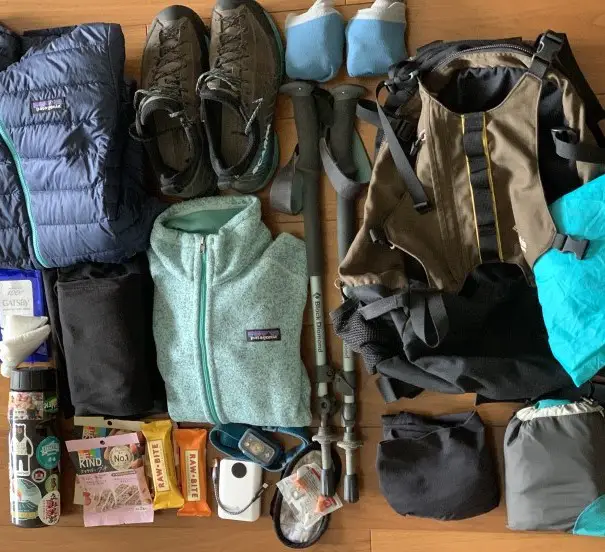
100. What to pack for climbing Mount Fuji?
Pack light, but also ensure you have everything you need on the mountain to stay warm and safe. Be prepared for all types of weather conditions and opt for comfortable shoes with good traction and support to minimize the risk of injury. Waterproof hiking boots are the best choice. And don’t forget to bring your favorite snacks as nothing will make you happier 🙂
Check my complete packing list for Mount Fuji here:
XXIV. ABOUT MY MOUNT FUJI EXPERIENCE
We all have a happy place, and for me Mount Fuji is that place in Japan 🙂
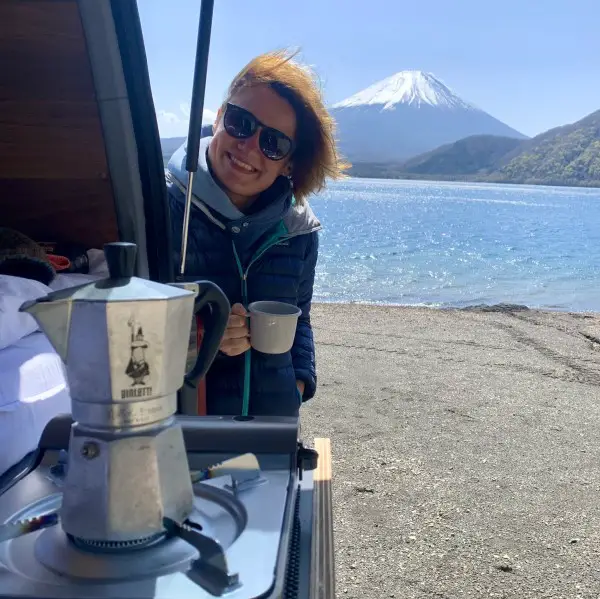
I’ve been living in Japan for almost 4 years and have climbed Mount Fuji three times:
- During the off-season via the shortest Fujinomiya (blue) Trail (1-day climb in May)
MOUNT FUJI OFF-SEASON ONE-DAY CLIMB – THE FUJINOMIYA TRAIL
2. Starting from the bottom via the Yoshida (yellow) traditional pilgrim’s route and descending the longest Gotemba (green) Trail (3-day climb in August)
3. Ascending via the Subashiri (red) Trail and descending the Prince Route (2-day climb in July), which is covered in this article.
While I’ve tried to cover everything you need to know about climbing Mount Fuji, if you still have questions or need more information, don’t hesitate to leave a comment, and I’ll be more than happy to help!
If you found this article helpful, please leave a comment as well – your feedback always brings a smile to my face 🙂
Happy hiking!
Beti

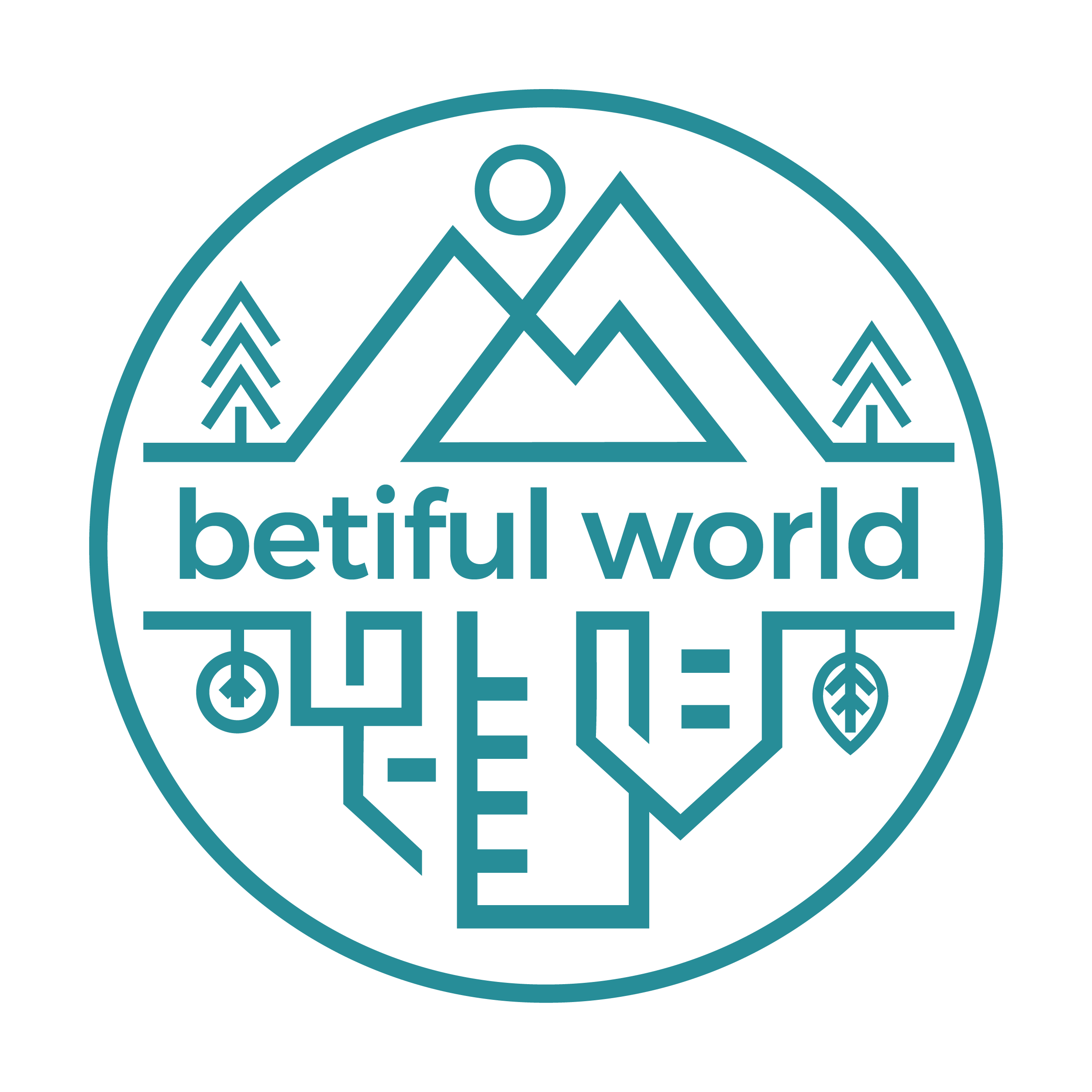
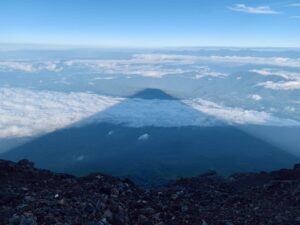
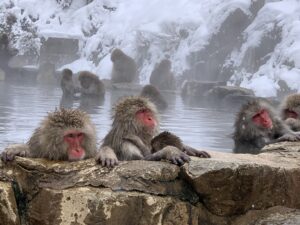
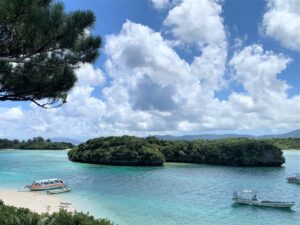
This is an awesome and useful blog for Mt Fuji. Thank you so much for writing this up.
Thank you so much Indri!
A fantastic website with lots of really useful information.
I’ve climbed Fuji 58 times ( 63 if I include double climbs )
So impressive! This means that your compliment counts 63 times more to me as you know Fujisan more than me! If I may ask, why did you climb it so many times? I’m so curious about your motivation.
Hi Beti! Thanks for the detailed post, sounds like amazing experience and it is very helpful.
I’m planning on climbing the 3776 route; have you done it? If yes, do you have any recommendations for the places to stay like PICA? Thanks in advance!
Fantastic … Thank you for such great articles !!
Thank YOU! My pleasure 🙂